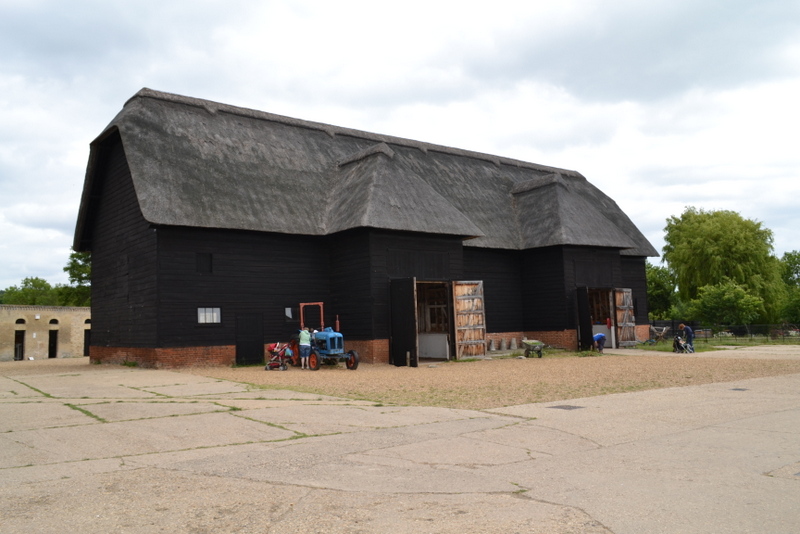After resting my eyes upon countless hillsides dotted with
grazing sheep in the Lake District, my visit to Wimpole Hall and Farm (a National Trust site) provided
a different rural perspective. Wimpole, located about 11 miles from
Cambridge, is a commercial lowland farm of 2,500 acres. East England’s rolling
hills are much more suited to what a local called “agriculture,” that is, the
growing of crops rather than animals. The weekend before my visit was the Rural Crafts and Scything Weekend, which culminated in the 6th Eastern Counties scything competition. I don’t know what sort of prizes the champions received, but I am sure it was a rollicking good time.
 |
| Cut hay in front of the hall (done using a scythe) |
 |
| Facade of Wimpole Hall |
The main block of the dates to 1640, and was designed by the
owner, an amateur architect named Thomas Chiceley. Subsequent side wings (of five
bays each) were added in the 18th century, by the architect James
Gibbs. The interior contains some reclaimed Wimpole items, but is mostly a
collection assembled during the twentieth century, not original to the house.
(In this way it reminds me of Carter's Grove, with its blend of antiques and
1930s furniture)
 |
| The rear elevation of the hall. |
 |
This National Trust image shows the book room -
Soane's elliptical arches can be seen in my photo below. |
 |
Another National Trust image (for some reason, their photos don't have random
people floating through them) of the library, designed by James Gibbs.
It was completed in 1730. |
The library features some modifications by Sir John Soane
and its 10,000 books forms the National Trust’s largest collection. At one
time, however, Lord Harley (later the Earl of Oxford, owner from around
1713-1740), a bibliophile to be admired, had 50,000 volumes, which served as
one of the founding collections of the British Museum.
 |
The Book Room, which leads into the much larger library.
These arches were added by Sir John Soane.
|
 |
| Formal dining room (available for your next event!) |
The Earl of Hardwicke bought the property in 1740, and it
remained in his family for 150 years. The 3rd Earl of Hardwicke (Phillip)
met Sir John Soane on the Grand Tour, and commissioned him to undertake several
renovations to the main house as well as design a “model farm” that instituted
some of the enlightened agricultural principles championed by the Earl. (The population of England tripled between
1750 and 1850, so some sort of agricultural revolution was needed to feed all
of those people)


The "Plunge Bath" at left and right was designed by Soane and installed in an existing courtyard at Wimpole Hall in 1793. It had hot and cold running water, and only required a mere 3,000 gallons to fill. (Hello, indoor pool) Apparently the intent was more to rid one of ill humors and disease rather than as a cleansing, hygienic exercise. The shower pictured at right was an early 19th-century invention filled directly from the bath.
Wimpole Hall has not yet fully restored the "downstairs" but it is likely that will happen as soon as feasible, given the immense popularity of shows like Downton Abbey. (Elsie Bambridge apparently changed many of the rooms in the 1950s) There are a few furnished and interpreted rooms in the basement, including the Dry Store, shown below.
During the 18th century, Wimpole’s Home Farm became known as one of England’s most progressive farming enterprises. Sir John Soane designed the Model Farm to be seen as a visitor progressed through the landscape, and its proximity to the Hall meant that the Earl could keep a watchful eye on his workers and production. (A 21st century innovation emulated the Model Farm roots, as the National Trust, inspired by the success of Facebook’s Farmville, opened up Wimpole Home Farm to the public as MyFarm.)
 |
| Soane's plan for the Farm complex. |
The Great Barn, the centerpiece of Soane’s courtyard design,
dates to1792. It.Is.Awesome. The barn is
the only surviving example of a timber frame barn designed by a major English
architect from the 18th century.
The barn sits on a raised brick foundation(keeps the rats
out) and is clad in black tarred elm weatherboards. The thatched roof , which
curves around the very tall double threshing doors (the ones in this photo were
scaled to accommodate carts piled high with wheat), is made of fen reeds
(harvested locally) with an oak frame. During the winter, farm workers would thresh
wheat in the barn.
 |
| The Great Barn |
 |
| Interior of the Great Barn |
Following the story line of any typical Regency Romance, Wimpole Hall was lost due to
the demon alcohol – the fifth earl, nicknamed
“Champagne Charlie,” enjoyed his social pursuits so much that the farm’s
coffers, (unlike the earl’s cup) ran dry. After selling off most of the
furnishings, Wimpole Hall was taken by the bank (around 1894), and the Hall
became a secondary home when used at all. The house and farm were greatly
neglected until the 1930s.
In 1938, George and Elsie Bambridge bought Wimpole Hall –
Elsie was the daughter of Rudyard Kipling and…she had English Cockers. Clearly,
I am destined for a grand English country house. Her husband died unexpectedly in 1943 – he and
Elsie were living at Wimpole in the basement at the time, due to WWII. Elsie
lived alone at Wimpole, overseeing its restoration, until her death in 1976.









